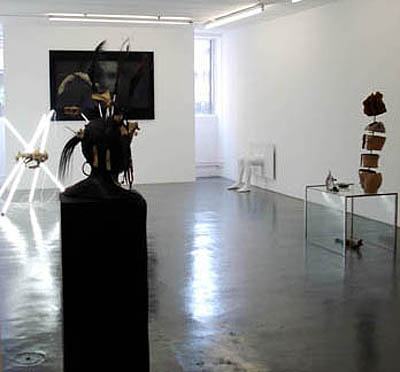the Agency |

_______________________________________________________________ Installation View, left to right S.Bishop, AK Furunes, Dallas Seitz, right and front
_______________________________________________________________ Installation View, left to right W.Cobbing, AK Furunes, Dallas Seitz
_______________________________________________________________ Installation View, left to right AK Furunes, Dallas Seitz front and rigtht
_______________________________________________________________ Installation View, left to right S.Bishop, AK Furunes
_______________________________________________________________ Anne-Karin Furunes
_______________________________________________________________ Dallas Seitz, Ate, Sculpture, mixed media
|
____________________________________The Enigma of William Tell and Other TalesSteve Bishop,William Cobbing, Dallas Seitz, The exhibition takes its title from a controversial painting by Salvador Dali, yet, Dallas Seitz's new sculptures delve directly into surreal references to Magritte and Dali, translating painterly language into sculpture, as well as playing on primitivism, which was the basis of much of the modernist attempt to break with representational conventions. In Ate , he presents a sculptural version of a modern-day cannibal's head from the South -pacific island of Vanuatu, the contemporary explorer's dream of discovering untouched tribalism. His second sculpture takes the taylor's dummy, common to surrealist iconography for the female body and de-feminises it, by replacing the head by a museal sponge, both reference and critique to museal preservation and curatorial mythmaking. Found objects in the style of curiosity cabinets open the possibility for multiple interpretations. William Cobbing's sculptures work with unexpected combinations of the real and the prosthetic, with the object and figures often conjoined in unexpected ways. In Sitzmachine the torso of a male figure vanishes in the back of a Marcel Breuer chair, the figure is like a growth to the chair or vice versa. Neither figure nor object make sense other than in their awkward combination and yet formally it appears as if the structures need each other for balance. Cobbing refers to the uncanny in scientific as well as psychological terms. Joe Currie's cast silver cow has a beak of a prehistoric bird of prey attached. Scientific references to cloning also play a role here as much as the desire to amalgamate real and mythological creatures with a knowing nod to the fact that science has progressed to being able to create the mutants of the modernist imagination. Steve Bishop presents a stuffed fox suspended on lighting rods that pierce the body like stakes, imbuing the work with a theatrical force. The inanimate neon-tubes appear to be giving movement to the dead animal, which is presented like a trophy. Anne Karin-Furunes wallbased perforated paintings are black punctured surfaces seen close-up, yet, when viewed form afar present photographic portraits of Finnish Soldiers from WWI. Furunes uses a technique whereby monochromatic canvases are perforated with multiple holes to create a non-space within the portrait emerges, thus appearing like a mirage. The works remain suspended between realism and the romance of a distant and unclear memory. All the works presented here are on the brink of realism and yet play on double-take and dreamlike shifts both in presentation and meaning. The result is both poetic and disquieting. The sculptures and paintings whilst adhering to their genres become dramatized and performative. In the case of the British based sculptors a new tendency seems to bind them together, which seems to not only refer to modern day urban myth making and the surrealism of sci-fi but also an echo of post-war British sculpture. Modernism and its many movements are currently seeing a re-surgence in contemporary art, not least since there is a need to re-address what once revolutionised art and lead to the dissolution of genres. In a spectacular return to genres a critique of museal archiving takes place in synchronicity with a re-examination of iconography and mythology in contemporary art.
|